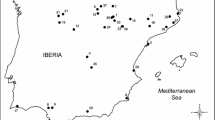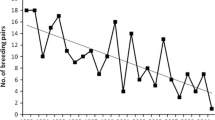Abstract
The Great Bustard is on the brink of extinction in Central Europe. Its population is known to suffer high mortality during hard winters, particularly when severe weather conditions cause migration. Long-term winter food management in two populations in Germany did not prevent migration events. To identify migration-triggering factors we tested the potential influence of snow, temperature, phase of winter and development of a tradition of migration. Comparing migratory behaviour with long-term local weather records, we found that snow cover is a much stronger trigger for migration than frost and low temperatures. We conclude that snow heavily affects the Great Bustard’s energy balance mediated not only by limited food access but also by the particular properties of its plumage. This could explain migration events despite food availability and is consistent with our results concerning a tendency for females to undertake facultative winter migration more than males. Available data are currently insufficient to confirm or reject the idea that Great Bustard populations develop a tradition of migratory behaviour following a previous winter migration, and we found no evidence for a decrease in the disposition of the Great Bustard to migrate during the course of winter.


Similar content being viewed by others
References
Alonso JC, Alonso JA, Martin E, Morales MB (1995) Range and patterns of Great Bustard movements at Villafafila, NW Spain. Ardeola (Madr) 42:69–76
Alonso JC, Morales MB, Alonso JA (2000) Partial migration, and lek and nesting area fidelity in female Great Bustards. Condor 102:127–136
Alonso JA, Martin CA, Alonso JC, Morales MB, Lane SJ (2001) Seasonal movements of male Great Bustards in Central Spain. J Field Ornithol 72:504–508
Berthold P, Mohr G, Querner U (1990) Steuerung und potentielle Evolutionsgeschwindigkeit des obligaten Teilzieherverhaltens: Ergebnisse eines Zweiweg-Selektionsexperimentes mit der Mönchsgrasmücke (Sylvia atricapilla). J Ornithol 131:33–45
Block B (1996) Wiederfunde von in Buckow ausgewilderten Großtrappen (Otis t. tarda L., 1758). Naturschutz und Landschaftspflege in Brandenburg 1\2:76–79
Collar NJ (1996) Family Otidiae (Bustards). In: del Hoyo J, Elliott A, Sargatal J (eds) Handbook of the birds of the world, vol 3. Lynx, Barcelona, pp 240–273
Collar NJ, Crosby MJ, Stattersfield AJ (1994) Birds to watch 2. The world list of threatened birds. Birdlife International, Cambridge
Cramp S, Simmons KEL (eds) (1980) The birds of the Western Palearctic, vol 2. Oxford University Press, Oxford
Dornbusch M (1981) Bestand, Bestandsförderung und Wanderungen der Großtrappe (Otis tarda). Naturschutzarbeit Berlin–Brandenburg 17:22–24
Dornbusch M (1983) Zur Bestandssituation der Großtrappe. Naturschutzarbeit in Berlin und Brandenburg 6:3–5
Dornbusch M (1987) Zur Dispersion der Großtrappe (Otis tarda). Ber Vogelwarte Hiddensee 8:49–54
Evans DL (1982) Multivariate analyses of weather and fall migration of Saw-Whet Owls at Duluth, Minnesota. J Raptor Res 16:95–96
Farago S (1990) The effect of heavy winters on Bustard (Otis tarda) populations in Hungary. Alatt Közl 76:51–62 (in Hungarian with English summary)
Farago S (1993) Development of Great Bustard populations in Hungary in the interval 1981–1990. Folia Zool 42:221–236
Farago S (1996) Lage des Großtrappenbestandes in Ungarn und Ursachen für den Bestandsrückgang. Naturschutz und Landschaftspflege in Brandenburg 1\2:12–17
Gauthreaux SA Jr (1978) The ecological significance of behavioral dominance. In: Bateson PPG, Klopfer P (eds) Perspectives in ethology. Plenum, New York, pp 17–54
Gauthreaux SA Jr (1982) The ecology and evolution of avian migratory systems. In: Farner DS, King JR, Parkes KC (eds) Avian biology, vol. 6. Academic, New York, pp 93–168
Gewalt W (1959) Die Großtrappe. Ziemsen, Wittenberg
Glutz v.Blotzheim UN, Bauer KM, Bezzel E (1973) Handbuch der Vögel Mitteleuropas 5. Akademische Verlagsgesellschaft, Frankfurt am Main
Hidalgo de Trucios SJ (1990) World status of the Great Bustard (Otis tarda) with special attention to the Iberian peninsula populations. Misc Zool 14:167–180
Hummel D (1983a) Der Einflug der Großtrappe (Otis tarda) nach West-Europa im Winter 1978/79. Vogelwelt (Wiesb) 104:41–53
Hummel D (1983b) Der Einflug der Großtrappe (Otis tarda) nach West-Europa im Winter 1978/79. Vogelwelt (Wiesb) 104:81–95
Hummel D (1985) A note on the invasion of western Europe by the Great Bustard in the winter seasons 1969/1970 and 1978/1979. Bustard Studies 2:75–76
Hummel D (1990) Der Einflug der Großtrappe Otis tarda nach West-Europa im Winter 1986/87. Limicola 4:1–21
Hummel D, Berndt R (1971) Der Einflug der Großtrappe (Otis tarda) nach West-Europa im Winter 1969/70. J Ornithol 112:138–157
Klafs G (1987) Schutz und Hege der Großtrappe Otis tarda L. In: Stubbe H (ed) Buch der Hege 2, Dt. Landwirtschaftsverlag, Berlin, pp 204–213
Koenig O (1979) Die Großtrappe (Otis tarda L.) Gegenwartsprobleme und Rettungsmöglichkeiten. Berichte der Forschungsgemeinschaft Wilhelminenberg, Wien
Kollar HP, Wurm H (1996) Zur Bestandssituation der Großtrappe (Otis tarda L., 1758) in Österreich. Naturschutz und Landschaftspflege in Brandenburg 1\2:7–9
Litzbarski H, Eichstädt D (1993) Naturschutz und Landwirtschaft im Großtrappenschongebiet Buckow, Kreis Rathenow. Naturschutz und Landschaftspflege in Brandenburg 2:37–45
Litzbarski H, Litzbarski B (1996) Zur Situation der Großtrappe Otis tarda in Deutschland. Vogelwelt (Wiesb) 117:213–224
Litzbarski H, Loew M (1983) Die Entwicklung der Großtrappenbestände unter den Bedingungen des Bezirkes Potsdam. Naturschutzarbeit in Berlin und Brandenburg 6:5–16
Litzbarski B, Litzbarski H, Petrick S (1987) Zur Ökologie und zum Schutz der Großtrappe (Otis tarda L.) im Bezirk Potsdam. Acta Ornithoecol 1:199–245
Ludwig B (1983) Bestandsentwicklung, Ökologie und Schutz der Großtrappe (Otis tarda L.) in der Notte-Niederung. Naturschutzarbeit in Berlin und Brandenburg 6:16–28
Ludwig B (1996) Neue Ergebnisse zum Bestand, zur Brutbiologie und-ökologie sowie zum Schutz der Grosstrappe (Otis t. tarda L., 1758) in der Notte-Niederung südlich von Berlin. Naturschutz und Landschaftspflege in Brandenburg 1\2:30–36
Morales MB, Martin CA (2002) Otis tarda Great Bustard. BWP Updat 4:217–232
Morales MB, Alonso JC, Alonso JA, Martin E (2000) Migration patterns in male Great Bustards (Otis tarda). Auk 117:493–498
Nelson K (1990) Bustard specialist group. Species (Gland) 55:13–14
Potapov RL, Flint VE (eds) (1989) Handbuch der Vögel der Sowjetunion, Bd. 4. A. Ziemsen Verlag, Wittenberg
Richardson WJ (1978) Timing and amount of bird migration in relation to weather: a review. Oikos 30:224–272
Richardson WJ (1990) Timing of bird migration in relation to weather: updated review. In: Gwinner E (ed) Bird migration. Physiology and ecophysiology. Springer, Berlin, Heidelberg, New York, pp 78–101
Schwabl H, Silverin B (1990) Control of partial migration and autumnal behavior. In: Gwinner E (ed) Bird migration. Physiology and ecophysiology. Springer, Berlin, Heidelberg, New York, pp 144–155
Smith HG, Nilsson JA (1987) Intraspecific variation in migratory pattern of a partial migrant, the Blue Tit (Parus caeruleus): an evaluation of different hypotheses. Auk 104:109–115
Sterbetz I (1980) Investigations into the nutrition of the Great Bustard (Otis tarda L.) in the winter aspect of 1977/78. Aquila 86:93–100
Terrill SB (1990) Ecophysiological aspects of movements by migrants in the wintering quarters. In: Gwinner E (ed) Bird migration. Physiology and ecophysiology. Springer, Berlin, Heidelberg, New York, pp 78–101
Triebl R (1987) Vogelkundliche Beiträge aus dem Neusiedlerseegebiet. Zugzeit- und Winterbericht 1987. Kurzbericht über die Großtrappenzählungen 1984–85 64:33
Watzke H, Litzbarski H, Oparina OS, Oparin ML (2001) Der Zug von Großtrappen Otis tarda aus der Region Saratov (Russland): Erste Ergebnisse der Satellitentelemetrie im Rahmen eines Schutzprojektes. Vogelwelt (Wiesb) 122:89–94
Wingfield JC, Ramenofsky M (1997) Corticosterone and facultative dispersal in response to unpredictable events. Ardea 85:155–166
Acknowledgements
The field observations comply with the current laws of Germany. The authors thank J. Fickel and M. East for improving the English and substantial suggestions. They also thank D. Hummel for helpful comments. Special thanks is devoted to C. Pitra, who initiated the research to this subject and contributed to an early draft. Beyond the scope of this paper, C. Pitra has, in all our years of mutual work, always put forward inspiring ideas as a colleague, as a cooperation partner, as head of the department, and above all, as a passionate and ambitious scientist.
Author information
Authors and Affiliations
Corresponding author
Rights and permissions
About this article
Cite this article
Streich, W.J., Litzbarski, H., Ludwig, B. et al. What triggers facultative winter migration of Great Bustard (Otis tarda) in Central Europe?. Eur J Wildl Res 52, 48–53 (2006). https://doi.org/10.1007/s10344-005-0007-1
Received:
Accepted:
Published:
Issue Date:
DOI: https://doi.org/10.1007/s10344-005-0007-1




